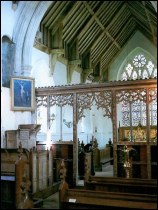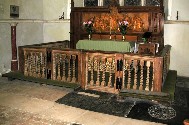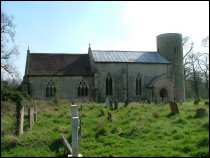| |
|
St Peter,
Merton
 |
|
As
I observed on the introduction to this
church, there is something incongruous about the
setting of St Peter. Its appearance is rugged and
primitive, like a building you might expect to
find lost in a forest; but here it is, set down
in polite parkland, with the mighty pile of
Merton Hall, former home of the Lords of
Walsingham, for company. It is
beside a major road, there are houses around, the
Diocese encourages its churches to be open and
all of the neighbouring ones are. But St Peter is
firmly locked, and there is no keyholder notice.
Is this the fault of the churchwardens, the Vicar
or the insurance company? Well, Ecclesiastical
Insurance encourages its churches to open their
buildings during the day, and as the Vicar here
is also responsible for open Thompson, we may
assume that it is the churchwardens' decision.
Perhaps
they have not heard that an open church is the
greatest act of witness that the Church of
England has.
|
I was
pleased that Tom Muckley was able to send me his image,
above, of the screen that he had taken in a more
enlightened age, because try as we might Chris Harrison
and I were unable to track down a key. Tom wrote the article about rood screens on this site, and
I know that he is a fan of the Merton screen, considering
it a fine one, and similar to that at his beloved Thompson nearby.
| But
I am reduced to recalling the outside, and
repeating what others have written about the
inside in books. Fortunately for me, fortunately
for us all, John Salmon has also been inside, and
you can see his images of the contents below. They
include an excellent collection of 19th century
glass - I know that this is one of John's areas
of interest, so he must have had great fun. There
are medieval bench ends, a fine piscina and
sedilia, and what is reportedly Norfolk's only
set of three-sided Laudian altar rails. It all
looks fascinating, and I wish I could have seen
it.
|
|
 |
 |
|
The
outside is not without interest. The round tower
has not been elaborated like that of nearby Breckles, and the
window tracery is like a textbook of the various
periods. The pre-Reformation north porch is
simple, but wholly preferable to the ugly,
pompous south porch built in the 19th century by
the Walsinghams as their private entrance. I
stood here, looking across at the idyllic setting
of the Hall, and was rather surprised when two
Llamas suddenly leapt inquisitively from behind a
tree and rushed across to investigate me. Fortunately,
a fence separated me from them, so they were
unable to force their snorting, slavering maws
into my crotch, in the manner of big dogs. As a
cat lover, I find myself incapable of
understanding why anyone would want to burden
themselves with the care of a large, stupid dog,
particularly one that so obviously wants to eat
me. "It's alright", their owners will
always shout from a safe distance, "he won't
hurt you!"
|
"No,
but I might hurt him", I always want to
call back, in my best Bill Bryson voice. Similarly, the
llamas caught the steely determination in my eye, and
backed off rapidly. It was only afterwards that I thought
I might have asked them where the key was.
Simon Knott, July 2004
You can also read: an
introduction to churches beyond the battle zone I
|
|
|


